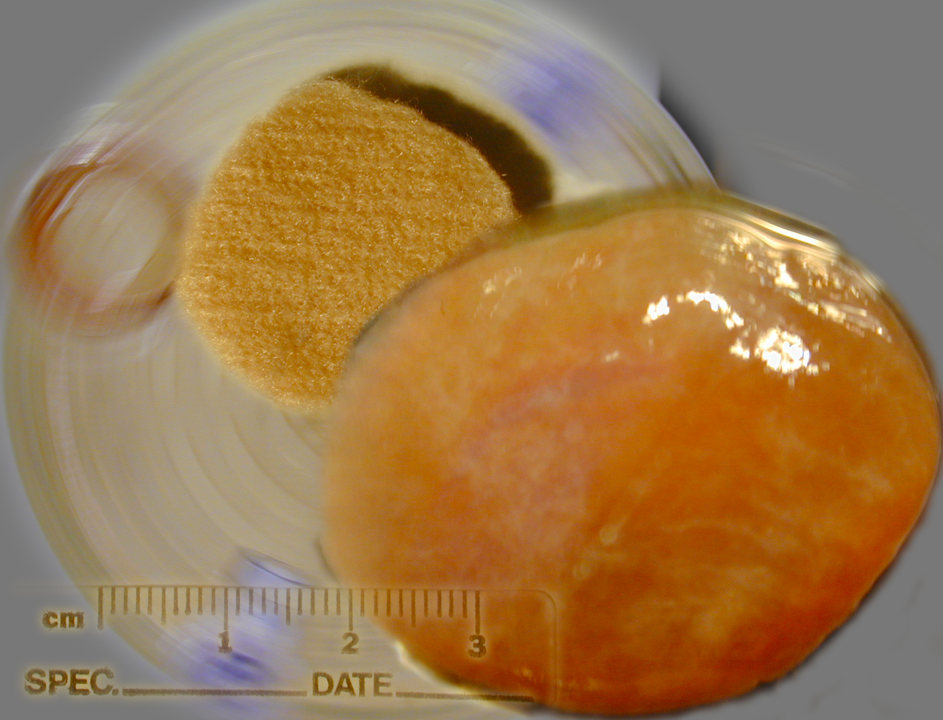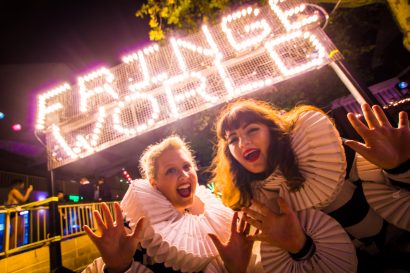A monstrous arts event is about to take place in Perth. Named “Unhallowed Arts”, it’s timed to celebrate the bicentenary of Mary Shelley’s Frankenstein and features exhibitions and events that explore that seminal text’s influence on contemporary life and culture.
While Frankenstein’s laboratory may be fiction, behind the monstrosity that is “Unhallowed Arts” is a real lab, SymbioticA. Curious, Nina Levy got in touch with Symbiotica’s director, Oron Catts, to find out more.
Nestled deep in the heart of the School of Human Sciences building at the University of Western Australia (UWA) is a laboratory with a difference. Make your way up to the second floor, past the fridges storing biological material, and you’ll find the home of SymbioticA, an artistic research laboratory in a biological sciences department. If that sounds like a contradiction in terms then you’re about to have your mind opened. Rather than viewing science and the arts as mutually exclusive disciplines, SymbioticA is predicated on the idea that the two are inextricably linked.
“We are interested in the concept of life and how our relationship to that concept is changing and shifting,” explains SymbioticA’s director, Oron Catts. “So it makes sense for us to park ourselves in the biological science department, where the most radical shifts in dealing with the idea of life, and life in general, are happening. Our research scope ranges from the molecular to the ecological but with a keen interest in contemporary biotechnological ways of engaging with life. What makes us really special is that we have our own research lab, a level two biological lab, specifically for artistic research.” For the non-scientists amongst us, according to Wikipedia, “level 2” refers to the level of precautions that need to be taken in order to ensure that dangerous biological agents remain contained within the lab.
Wow.
In addition to enabling artists and researchers to engage in wet biology practices, SymbioticA also hosts residents, workshops, exhibitions and conferences. Based at UWA since 2000, SymbioticA was founded by Catts and Dr Ionat Zurr, now the academic co-ordinator. As Catts explains, from the beginning SymbioticA has been concerned with the idea that the rapidly developing field of biotechnology, which allows biological and genetic materials to be manipulated, needs the input of artists as well as scientists.
“The main reason SymbioticA got started was this interest in the idea that biology is becoming more and more of an engineering pursuit and [that] life [is becoming] the raw material for human wants and needs,” he elaborates. “We felt it was really important for artists to also start to use the living biological materials … if other professions are allowed to do it, it’s particularly important for artists to explore this area because we need to make sense of what it means to treat life in such a way.
“We try to be non-prescriptive … We’re not trying to tell [our residents and students] how to think about these issues, we’re trying to make them aware of those issues and trying to find different strategies to open up those questions to the wider community and get them involved in the awareness that something very, very strange is happening to life and that we shouldn’t leave those decisions about we’re doing [solely] to scientists, business people and engineers.”
As the name suggests, SymbioticA is founded on the idea that there is a symbiotic relationship between science and the arts – “the capital S stands for science and the capital A for arts,” says Catts – but he is anxious to emphasise that it’s not about outcomes or benefits for either field. He is wary of what he refers to as “the innovation paradigm.” He elaborates, “That’s the neoliberal idea that we always have to come up with gadgets and innovations to justify our existence. We try not to revert to that rhetoric because we believe that there’s way more important things to think about than just short-term profits… in most cases, they’re not even benefits.” Instead, he says, SymbioticA is engaged in a “critique of life science.”

That said, SymbioticA has been involved in some exciting scientific developments, continues Catts. “We have quite a few scientific applications that have come out of SymbioticA … because the nature of the questions we ask can generate new knowledge, just by engaging with queries that artists have around the materiality of living systems and what can be done to them. We are credited, for example, with being the first place that was growing meat in the lab, and growing leather. We did that very early in the game. We have an artist here, Guy Ben Ary, who is also one of the technicians and is doing a lot of work with neuroscience and stem cell research and he has worked very closely with scientists to develop new ways of doing things.
“But first and foremost, we focus on the idea that we are living in a time when life is going through major transformations and there is a need for a wide variety of approaches in dealing with [the questions that arise as a result]. We represent one approach, which is experiential … we train the artists in techniques, so that they’re not looking over the shoulder of scientists, they’re actually working in the lab, with the materials and they gain a very intimate understanding of the field which allows them to be much more informed about the possibilities. This is another issue we have at the moment – the meat is a prime example, it’s being hailed as something that might save the world, but we see it as a symptom of the ailments of the world, rather than solving the [world’s] problems.”
It’s unsurprising, then, to learn that in spite of keeping a relatively low profile at home, SymbioticA has an international reputation. That low profile at home is about to change, however. Throughout September and October SymbioticA will be revealing itself on a monstrous scale, with “Unhallowed Arts”, a collection of arts events at various venues in Perth and Fremantle. The title is a tongue-in-cheek reference to comparisons that have been made between Mary Shelley’s Frankenstein and his creature, and the SymbioticA artists working in their lab. Initially unwanted, the group has decided to embrace the comparison. It’s timely, as 2018 is the bicentenary of the publication of Shelley’s gothic novel.
The initial idea for “Unhallowed Arts” was to hold a conference, says Catts, but with overwhelming interest, it quickly developed into a much larger scale event, with exhibitions at the Art Gallery of WA, the Perth Institute of Contemporary Arts, Old Customs House (Fremantle), UWA’s Cullity Gallery and Paper Mountain, and a film program at the State Library, in addition to “Quite Frankly”, the conference being held at UWA.
One of these exhibitions is developed by Catts and Zurr as part of their Tissue Culture and Art Project. Intriguingly entitled “Biomess”, it is curated by the Art Gallery of Western Australia’s Curator of Contemporary Design and International Art, Robert Cook, and opens at AGWA, September 8. As the name suggests, the exhibition looks at what Catts describes as “the messiness of biology”.
“Biomess” started with Catts and Zurr approaching curators at the WA Museum. “We asked them if they have any specimens in their collection of organisms that defy a sense of self or body or reproduction,” says Catts. “We were starting to thinking about it around the time of the same-sex marriage plebiscite, when conservatives would use [arguments] like, it’s not natural to engage in particular sexual relationships. When you look at the way living biological systems deal with [sexual relationships], there is such a variety, so many organisms that change their gender in their lifetime, organisms that reproduce in different ways. One example, which unfortunately we don’t have in our show, is a bird that has two variants of the male, where one male looks like a female. The [female-looking male] gets the male-male to mount them. When they do so they transfer the sperm into the male-male and then that bird mounts the female. So the manly male is the vehicle for the feminised male to transfer its sperm into the female.”
While that example won’t be seen, there are plenty of fascinating specimens that will be part of the exhibition, says Catts. “An amazing example is that there’s a beetle where the male started to fall in love with a specific beer bottle, to such an extent that they lost interest in females and were only mounting the bottles. Biologists went to the brewery and asked them to change the design of the beer bottle because there was a risk that the beetle would go extinct from fetishizing the bottle.
“We have a marsupial that the males, when they reach sexual maturity, they stop everything and just procreate until they die of exhaustion.
“There are other organisms that are hermaphrodites, there’s fish that change their gender from female to male. There’s only one dominant male, so if that male disappears or dies, one of the females in the group becomes male.”
While that sounds fascinating enough, there’s another twist. “We’ve commissioned the designers who build the luxury display cases for David Jones to build display cases for the specimens. The idea is that when you enter the gallery you’re not sure if you’re in art museum, a natural history museum or a luxury shop,” elaborates Catts. “That will be contrasted with an incubator that we’re designing here. We’ll have living organisms there: snails, slugs…” he pauses to throw the question to taxidermist Teori Shannon, “What else will we have?”
“Stick insects, these pink sea cucumbers, some starfish… we’ve got these snails that can grow bigger than a tennis ball. They’re really nice,” replies Shannon.
“And then we’ll have lab-grown life,” continues Catts. “We are working with what’s called the hybridomas. As early as the late 1960s scientists found a way to fuse cells from different organisms to grow together and become one new organism … it’s a lifeform which can only exist within the confines of a lab, but defies any form of classification. You have human/mouse hybridomas, you have mouse/horse hybridomas, some of them have three different organisms.”
Listening to Catts talk I feel like I’ve slipped into some kind of futuristic sci-fi fantasy film set… except that I know that I am sitting in the Biological Sciences building at UWA. At the point where arts and science intersect it seems that anything is possible.
Catch Biomess at the Art Gallery of WA, September 8 – December 3. Find out more about that exhibition and the rest of the “Unhallowed Arts” program at https://unhallowedarts.org/
Pictured top: Disembodied Cuisine Installation, by the Tissue Culture & Art (Oron Catts, Ionat Zurr & Guy Ben-Ary), medium: mix, 2003. Photo: Axel Heise.
Like what you're reading? Support Seesaw.






